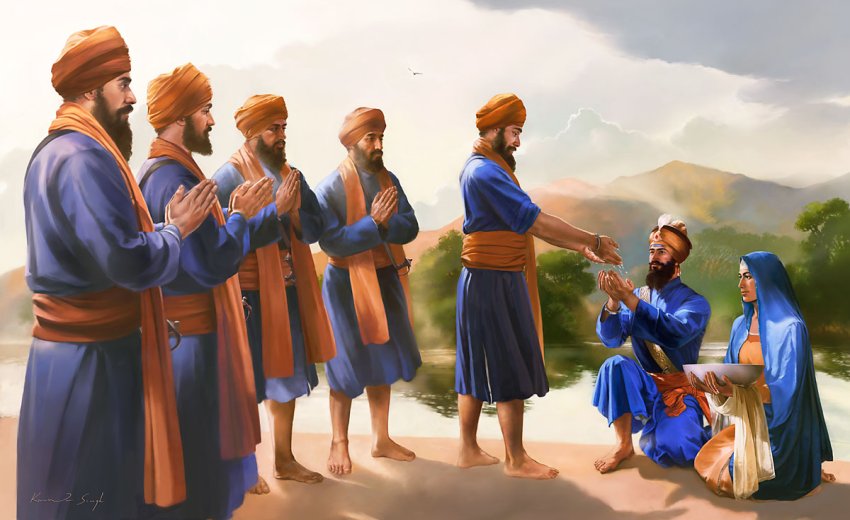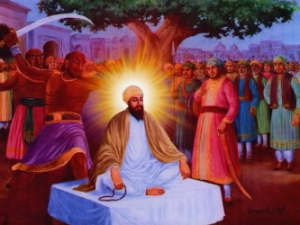Lately, I have been asking myself what it means to be Khalsa. I think many of us have an idealized version of Khalsa in our minds. Perfect bana. Perfect recitation of Bani. Good behavior. Defender of the weak and the poor. We retell the story of Vaisakhi every year. The power and radiance of that moment in 1699 has left a huge imprint in our collective psyches.
As a community, we Sikhs have tried to pass down and manifest this ideal of Khalsa for over 300 years. For 15 generations. But the truth is, nobody video recorded Vaisakhi in 1699. Nobody took notes of what was said and done. We have stories and we have questions about those stories. Some of us long to understand and obey what the Guru asked of us. But understanding and obedience is not necessarily easy.
The form of the Khalsa seems clear. The 5 banis. The 5 symbols of faith. Those aspects seem simple enough to replicate, even if the discipline is not necessarily easy.
But the form of Khalsa ultimately invites us into a unique consciousness. Into a unique relationship with the Guru. And it is that consciousness that I would like to discuss today.
I have been doing a little bit of research into what actual records we have of things Guru Gobind Singh ji said. When we look at this question of Khalsa consciousness, the Rahitnama of Bhai Nand Lal ji offers some clues. The Rahitnama of Bhai Nand Lal ji is based on a conversation he had with Guruji in 1695, four years before Vaisakhi. There are two aspects of this that I would like to highlight today.
The first has to do with the sight of the Guru, the darshan of the Guru, and how Guru Gobind Singh ji described the projection of the Guru in three aspects.
Like a light refracted through a prism, there are three manifestations of the Guru.
The first, of course is the Shabad. The sacred songs. Collected in the Siri Guru Granth Sahib, which presides in Guru Ji’s Darbar.
“Hearing the Shabad with concentration, and by putting mind into the Guru,
He should listen and make others heed the Guru’s enlightening Shabad. (17)
One who wants to communicate with me,
He may read, listen to and ponder over Granth Jee. (18)
One who aspires to listen to my sermons,
Diligently, should he read and recite Granth Ji. (19)”
We all know this. That if we wish to meet the Guru and merge ourselves with the Guru, the study and recitation of the Shabad can point our minds in the correct direction. But in this poem by Bhai Nanad Lal ji, the Shabad is not the only place to attain the sight of the Guru.
Another place to see the Guru is in the Sikh who meditates upon the Shabad.
“My Sikh is my third embodiment,
Who remains imbued in the essence of Gurbani day and night. (21)”
The Guru can become visible to me through a devoted Sikh who listens to the Shabad, who talks about it, who serves others and who relinquishes ego. So - can we develop the sensitivity to see the Guru in the heart of someone who loves and serves the Guru? Can the word of a Sikh guide us? Can the help of a Sikh uplift us? Can our consciousness look beyond the individual person so we can see the radiance and majesty of the Guru?
Even more important, are we willing, ourselves, to allow the Guru to shine through our words and our service? Can we meditate upon the Shabad, and by so doing, become a channel for the Guru’s touch and the Guru’s sight?
It is a profoundly deep statement that the Guru can be witnessed in his Sikh. It is in many ways a challenge, where the Guru asks us to see the His light in each other. And to see the Guru’s Light in ourselves FOR each other.
Bhai Nand Lal ji shares with us in the Rahitnama that Guruji can be experienced through the Shabad and through the Sikh. But that is not the end of it.
The third avenue to see the Guru is actually no form at all. A Transcendental aspect that is infinite.
And what does that mean - Transcendental?
“There is one Perception, which is beyond all the three attributes.
Which has been expounded many a time in Vedas. (11)
The Almighty invests in every heart
And is indivisible as water in the pitcher. (12)”
Can we understand that the Guru has the power to communicate with us, to touch us, at any moment? Through any channel? If we just have the devotional love, the receptivity, to see it?
Can you feel the Guru in the touch of a breeze? Hear His voice in the words of a poem? See His example in the innocence of a child?
Once the mind has connected to the Shabad, once the Sikh becomes the Guru’s embodiment, can we realize that the Guru is ever-present, everywhere, at all times, in all ways?
Can we experience the Guru as beyond form, as Infinite?
Today, on this Vaisakhi, I am challenging myself to broaden what Khalsa means to me in my own mind. And if you are so inclined, I would like you to take this challenge, as well. To look past the form and ritual of Khalsa, the perfect bana and the recitation of the Banis, and to understand from the Rahitnama of Bhai Nanad Lal ji that all the external practices we received from Guru Gobind Singh ji on Vaisakhi, all of them are meant to awaken in us this unique consciousness. This special relationship. Where we can see the Guru before us, today, this moment, in three ways:
-
In the Shabad
-
In each other and in ourselves as Sikh
-
And then to see beyond sight, beyond any form or any limit.
I would like to end this talk by sharing one other aspect of Bhai Nand Lal ji’s Rahitnama. It is something that is incredibly important to the cultivation of this Khalsa consciousness.
“Sikhs of the Guru, listen, My Companions,
Getting up early in the morning, conceive God in the mind. (1)
Then recite the incantation of Waheguru, the Supreme Being,
And after ablution, read and recount Jap Jaap. (2)”
Getting up early in the morning, Amrit Veyla, is a core component to finding and realizing Khalsa consciousness.
I can tell you with certainty that I would have never become a Khalsa myself without meditating early in the morning.
When I have a strong morning practice, I can take the challenges of life in stride. When I let my morning practice suffer, I suffer.
To the extent that Sikh Dharma has risen in the West and around the world, among people from many countries and cultures, it is because Siri Singh Sahib Bhai Sahib Harbhajan Singh Khalsa Yogiji insisted that we rise in the early morning and meditate.
If you enjoy SikhNet’s services - The Gurbani Media Center, the Sikhnet News, the Children’s Audio Stories, the resources relating to Bani, the Kaur movies - this website was built and is maintained by people who rise early in the morning and meditate. Without the Amrit Veyla practice, SikhNet would not exist.
There is tremendous virtue and power in rising up before the start of the day and cleaning oneself. Facing yourself through simran. Without facing ourselves, how can we face any other? And what kind of face will we have?
When we rise in the early morning, in the Amrit Veyla, the entire Khalsa nation rises.
When we sleep in the early morning, the Khalsa nation sleeps.
The fact is - this body, this breath, this chance, belong to you and you alone. No one can do it for you. And no one can prevent you from doing it, if you decide to take advantage of it. It is your life. It is your chance. It doesn’t belong to anyone else but you.
So on this Vaisakhi, I would like to leave you with some questions.
-
How can we cultivate the Darshan of the Guru in our lives?
-
How can Khalsa become an experience we live, rather than a form we preserve?
-
Can you give to yourself, right now, tomorrow morning and thereafter, the gift of rising before the sun and chanting God’s name? If you miss a morning. Waheguru! There will be a new morning. Just keep up and keep going.
Everyone has the seeds of the Khalsa planted within them.
It is up to us to nurture those seeds so they can grow.
Wahe Guru Ji Ka Khalsa, Wahe Guru Ji Ki Fateh!
Art by Kanwar Singh at ArtOfPunjab.com






